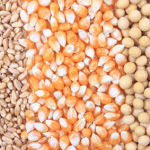Bumper Crop Takes A Toll On Agriculture ETFs – CORN, WEAT, MOO
A s October gets underway, fall is in the air, football is in full swing, and the annual corn harvest is underway.
s October gets underway, fall is in the air, football is in full swing, and the annual corn harvest is underway.
And what a harvest it will be…
The Corn Belt has had nearly ideal growing conditions this year. The US Department of Agriculture is expecting US corn production to set a new record of 14.5 billion bushels this year.
It’s a dramatic change from the conditions two years ago. Back then, a drought griped the central part of the US causing production to come up short of expectations and commodity prices to soar.
What’s more, commodities were already hot because of the perception of the Fed’s QE program. There was widespread speculation the bond buying program would crush the value of the US Dollar.
Many investors invested in commodities and commodity ETFs to protect themselves from the devaluation of the US Dollar because the value of commodities priced in dollars tend to go up when the value of the dollar goes down.
As a result, corn, soybean, wheat, and other grains soared in value.
Today, it’s a much different story for agricultural commodities.
As I already pointed out, there’s a bumper crop in the fields. In fact, there’s so much corn that it’s expected to overwhelm the railroads capacity to transport it from the central producing states to the coasts for processing and exportation.
What’s more, after a record setting crop last year existing stockpiles of corn are already higher than expected. The US has 1.236 billion bushel of corn in storage right now from last year’s crop. That’s up from 821 million bushels last year at this time.
The US is literally bursting at the seams with an oversupply of corn. And thanks to a decline in the size of the US cattle and pig herds, there’s not enough livestock to feed the stuff to.
Thank goodness we have ethanol plants to absorb some of the excess supply of corn. Without them, the situation would be much worse. People were killing ethanol producers a few years ago, now they’re heroes.
Nevertheless, corn prices are down more than 50% since the peak in 2012.
And it’s not just the oversupply of corn that’s causing the bottom to fall out of the US corn market… the value of the US Dollar is going up in value right now as well.
The relative strength of the US Dollar is hurting corn and other commodity prices.
It’s also clear that the speculation about the demise of the US Dollar was pure nonsense. As a result, many investors are pulling out of their commodity investments they made to protect themselves from the devaluation of the US Dollar.
In other words, it’s a perfect storm of events that are crushing grain prices. And the biggest loser of all is the American farmer. After a few years of record profits, net farm income is expected to fall 14% this year.
That’s bad news for farmers that have been taking on debt to expand their operations and purchase land at record high prices. And it could get worse if interest rates start to rise next year.
We could see farmers get pinched between low commodity prices, high input costs, and rising interest rates that make the debt they took on while rates were low and commodity prices high unaffordable.
Needless to say, it’s a dangerous situation for farmers and investors alike.
This one situation where an investor’s only option is to bet on lower prices or get out of the way. There’s no reason to expect the current market dynamics to change in next 12 months.
You have to avoid ETFs like the Teucrium Corn Fund (CORN), Teucrium Soyben Fund (SOYB), and Teucrium Wheat Fund (WEAT). These ETFs are tied directly to the value of futures contracts for corn, wheat, and soybean commodities.
And you also need to avoid the Market Vectors Agribusiness ETF (MOO). This ETF holds stocks of companies that produce seeds, chemicals, fertilizers, farm equipment, and other agribusiness stocks.
These stocks are going to get hit hard by the drop in net farm income and rising interest rates. American farmers simply won’t have the ability to spend like they have over the last few years.
Here’s the upshot…
It’s been a great year for growing crops in the Midwest, but that’s about the only thing that’s going right for the agricultural commodities and agribusiness right now.
And it’s likely to get worse as more investors get shaken out of their investments over the next six months. This is one situation investors should look at shorting or just get out of the way… there’s no reason to bet on a bottom forming yet.
Good Investing,
Corey Williams
Category: Commodity ETFs, ETFs




